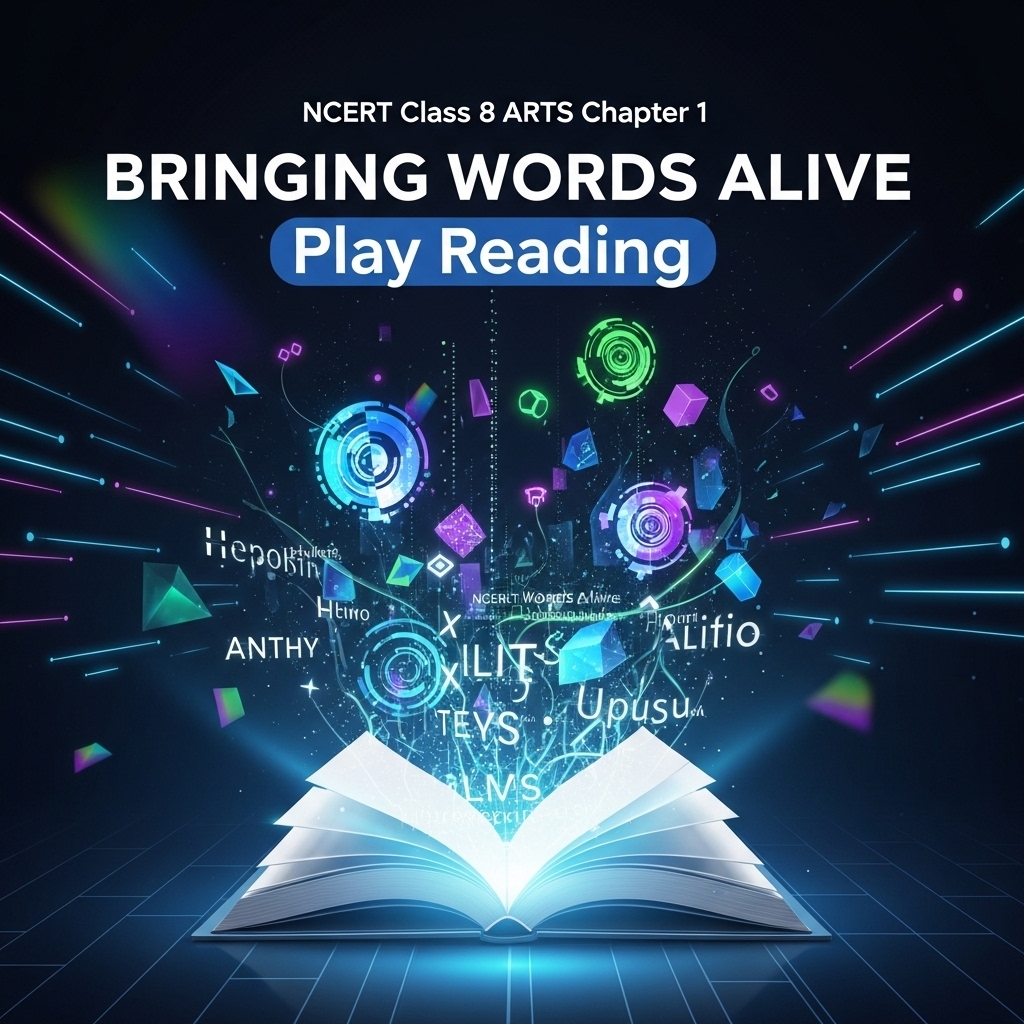Bringing Words Alive: Play Reading and Voice Training – NCERT Class 8 Theatre Chapter 1
Building clarity, diction, voice modulation, and emotive speech through play reading to develop theatrical and communication skills among Class 8 students.
Updated: 2 months ago

Bringing Words Alive - Play Reading
Chapter 1: Theatre
Complete Study Guide with Interactive Learning
Chapter Overview
What You'll Learn
Play Reading as Performing Art
Understanding rehearsed reading without sets, props, or costumes, focusing on voice to bring scripts alive.
Voice Training
Exploring clarity, diction, volume, pitch, and emoting through speech for effective delivery.
Impactful Speaking
Learning how speech impacts emotions and communication, drawing from Natyashastra principles.
Assessment and Reflection
Using circle time, rubrics, and summative activities to evaluate theatre skills.
Historical Context
This chapter introduces play reading through Abhinava Gupta’s commentary on Natyashastra, emphasizing integrated performance elements. It builds on Grade 8 students' prior theatre exploration, focusing on voice as the core of Vachika abhinaya.
Key Highlights
Play reading sharpens imagination and connects text to audience via voice alone. Activities like tongue twisters and gibberish enhance speech clarity and emoting, while assessments foster reflection and teamwork.
Comprehensive Chapter Summary
1. Introduction and Quote from Abhinava Gupta
The chapter begins with a quote from Abhinava Gupta’s Abhinava Bharati, likening a well-integrated performance to a garland of flowers, teaching four types of knowledge. Abhinava Gupta (10th-11th century CE) added shanta rasa to Navarasas.
2. Note to Teachers
Student Development
Grade 8 marks consolidation; students become performers, collaborators, and thinkers. Book assimilates prior skills in movement, expression, storytelling, and stagecraft.
Assessment Overview
Emphasizes process over outcome. Criteria: Knowledge application, effort, creativity, teamwork. Levels: Formative (circle time, rubrics), Summative (activity-based).
Formative Assessment
Circle time for reflections; rubrics for self and teacher grading per chapter.
3. Rehearsed Reading
Definition and Practice
Performed without sets/props; actors read aloud in regular clothes, using voice for characters and emotions. Similar to singing; focuses on vocal cords, pitch, volume.
Related Forms
Radio plays, voice acting, dubbing share concepts but not staged.
Improvement Areas
Clarity, diction, emoting through speech; voice production via three subsystems (air pressure, vibratory, resonating).
4. Voice Subsystems and Comparisons
Three Subsystems
Table details organs and roles: Diaphragm/lungs for air pressure, larynx/vocal cords for vibration, vocal tract for resonance.
5. Activities for Voice Training
Clarity and Diction
Activity 1.1: Tongue twisters; Activity 1.2: Speed, intonations, word impact example.
Volume, Pitch, Emoting
Explanations with animal examples; Activities 1.3-1.5: Guess animal emotion, actor lines, gibberish for non-verbal communication.
6. Reflection and Recommendations
Circle time questions; recommended plays in English/Sanskrit; Natyashastra quote on speech importance; life lessons on effective communication.
Key Concepts and Definitions
Rehearsed Reading
Performance without sets/props; focuses on voice to convey characters and emotions.
Vachika Abhinaya
Speech or language in performance, including songs in dance.
Voice Subsystems
Air pressure, vibratory, resonating systems producing sound.
Tongue Twisters
Phrases with similar sounds to improve pronunciation and clarity.
Diction
Clear articulation, including speed and intonations.
Gibberish
Random sounds for emoting without meaningful language.
Important Facts and Figures
Questions and Answers from Chapter
Short Questions
Q1. What is rehearsed reading?
Q2. What is Vachika abhinaya?
Q3. Name one tongue twister from the chapter.
Q4. What is volume in speech?
Q5. What is pitch in speech?
Q6. What is gibberish?
Q7. What is circle time?
Q8. Name one voice subsystem.
Q9. What is mime?
Q10. What does diction involve?
Q11. Give an example of an animal with loud volume and low pitch.
Q12. What is the role of vocal cords?
Q13. Name a recommended English play.
Q14. What is formative assessment?
Q15. What is intonations?
Medium Questions
Q1. Explain clarity in speech.
Q2. Describe the air pressure system.
Q3. What is diction and how to improve it?
Q4. Explain volume with an example.
Q5. What is pitch with an example?
Q6. Describe basic gibberish activity.
Q7. What is circle time?
Q8. Explain Vachika abhinaya.
Q9. What is the vibratory system?
Q10. Describe intonations.
Q11. What is mime?
Q12. Explain advanced gibberish.
Q13. What is summative assessment?
Q14. Describe resonating system.
Q15. What are rubrics?
Long Questions
Q1. Explain the three voice subsystems in detail.
Q2. Discuss the importance of speech from Natyashastra.
Q3. Describe Activity 1.1: Clarity in Speech.
Q4. Explain volume and pitch with animal examples.
Q5. Describe Activity 1.5: Emoting Through Speech.
Q6. Discuss formative and summative assessments.
Q7. Explain Activity 1.2: Diction.
Q8. What are key takeaways for life?
Q9. Describe Activity 1.3: Guess the Animal Emotion.
Q10. Explain Vachika abhinaya and its relevance.
Q11. Discuss note to teachers on student growth.
Q12. Explain Activity 1.4: If You Are An Actor.
Q13. Describe recommended plays.
Q14. Explain circle time questions.
Q15. Discuss note to teacher on gibberish.
Interactive Knowledge Quiz
Test your understanding of Bringing Words Alive - Play Reading
Quick Revision Notes
Rehearsed Reading
- No sets/props
- Voice focus
- Emote through speech
Voice Training
- Clarity/diction
- Volume/pitch
- Gibberish
Subsystems
- Air pressure
- Vibratory
- Resonating
Assessment
- Circle time
- Rubrics
- Summative
Exam Strategy Tips
- Practice activities
- Understand Natyashastra
- Explain examples
- Use tables
- Reflect on life lessons

Group Discussions
No forum posts available.
Easily Share with Your Tribe


